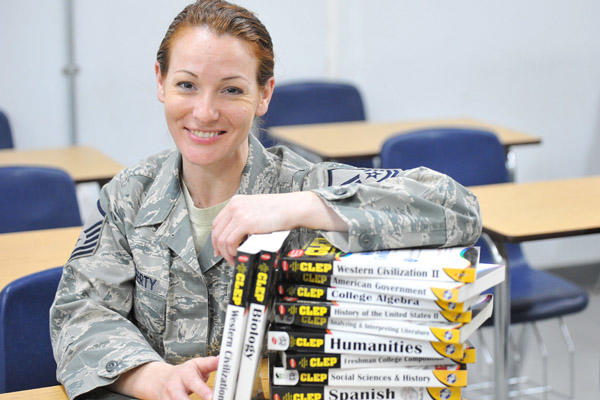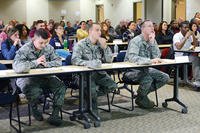When I think of veteran students, a quote by Theodore Roosevelt comes to mind: "A man who is good enough to shed his blood for his country is good enough to be given a square deal afterwards."
Over 43 million men and women have served in our nation’s military since the American Revolution…34 million of those since 1940…over 1.5 million since 2001. Even then, less than 1% of our nation’s population has ever served, allowing the remaining 99% to enjoy the freedoms so often taken for granted.
A little over three years following the execution of the most generous GI Bill (or square deal) in history, more colleges and universities are seeking to capture the attention of active military members, veterans and their families. As a veteran following 22 years of active service and now an administrator in higher education with Lipscomb University, I’d like to think that this pursuit is motivated by appreciation and generosity; however, the reality is some institutions of higher learning tend to focus more on the revenue potential and less on the individual's potential.
Like a bug drawn to the warm luminescence of a "bug zapper," many of our fellow veterans and their families are drawn to the most appealing advertising generated by both traditional brick and mortar schools and those who specialize in on-line education. "Military Friendly" is the opening headline generally followed by "we are a Yellow Ribbon school." What exactly does this mean? In truth, only a veteran can determine if a particular institution is "military friendly," and almost any school can become a Yellow Ribbon participant.
As military members depart their respective service, how do they begin to navigate through the overwhelming sea of university, college and technical school advertising rhetoric? First of all, ask yourself "what is the goal or end-state you desire to achieve?" Is it a formal degree, technical training credentials or merely the pursuit of adult continuing education in various areas of interest? Establishing this up front will help you to avoid the "impulse purchase" pitfall that many fall prey to motivated by their rush to get into any college or their failure to look deeper into what the institution has to offer to meet their specific needs.
Institutions of higher learning that are investing in the necessary infrastructure to service the needs of veterans have programs easily identified for your review. As you begin sorting through the many options, consider a few environmental factors of the day. There are roughly 23. 5 million living veterans, which comprises almost 9% of our nations population. Over 1. 4 million veterans have entered the civilian workforce since 2002 and there are nearly 200,000 transitioning from military service each year. Therefore, your choices regarding your educational future are vital to distinguishing you from the rest of the herd. When considering an educational institution, consider the following factors:
- Liaison or Service Director. Does the school have a dedicated veteran representative who understands the specific needs of veterans and assist with benefits and admission? Many schools assign this as an additional activity within the admissions or registrar offices and thus don’t give this endeavor the attention needed.
- Centralized Services. Does the school have a dedicated office or center to provide the resources and cross-campus connections needed by incoming veteran students? The school doesn’t have to provide a one-stop-shop to be effective, however, ensure it has a clearly defined network structure that is continually cultivated by a central office.
- Counseling Service. Despite the former advertising slogan, not one of us is an Army of one and we all need assistance at some point. Even if you feel this is not something you will need during your academic pursuit, add it to your list of requirements and ensure the school has adequate academic, personal and financial counseling services.
- Associations. Those schools that are best at servicing veteran students seek to connect and join various organizations such as the Servicemember Opportunity Colleges (SOC) which is a consortium in cooperation with 15 higher education associations, the Department of Defense, and Active and Reserve Components of the Military Services to expand and improve voluntary postsecondary education opportunities for service members worldwide.
- Credits. Ensure the school accepts military credits following the American Council on Education (ACE) guidelines and understands how to evaluate ART, SMART and CCAF transcripts.
- Student Veteran Organizations. Don’t underestimate the influence and necessity of a student veteran organization on campus. Setting aside the obvious social and campus awareness impact of such organizations, a student veteran organization can assist with ensuring the best interest of veteran students are continually considered by school leadership as well as further engraining the program into the fabric of the school. This is even more important if attending a school that is not in close proximity to a military installation.
- Web Presence. How far down you have to drill to reach veteran-related information can speak volumes to the schools emphasis regarding veteran service programs. Ensure the schools site provides clear links to a veteran specific page, contact information for the schools VA certifying official is listed and links to other veteran resources are provided.
The most important thing to remember is you determine where and how your education benefit is spent. Regardless of how "military or veteran friendly" the school is, there is a business element involved and you have leverage. Depending on the level of involvement of the school within the Yellow Ribbon program; at a private institution you could potentially generate up to $35,000 in annual revenue (assuming you use 100% Post-911 benefits along with Yellow Ribbon).
Finally, only a veteran can determine if a particular school is "veteran friendly" and even that perspective varies by individual. As you interact with school representatives during the admissions application and financial aid process, you will gain a sense of the environment fairly soon. Ask a simple question up front, "do you waive the application fee for military and veteran students?" Experience shows if they say no, the odds are likely that many of the aforementioned support programs will not be in place.
I hope this advice has been beneficial as you begin your search for the right educational institution to meet your goals. Good hunting!

Jim Humphrey earned his undergraduate degree in Kinesiology in 1992 from Angelo State University. He later earned graduate degrees in Aeronautical Science from Embry-Riddle Aeronautical University and Military Operational Art and Science from Air University. Jim is a retired Lieutenant Colonel from the U.S. Air Force following 22 years of military service and has deployed numerous times to the Middle-East region in support of operations in Iraq and Afghanistan. Jim's primary focus is the care and success of our veteran students. The Veterans Service office provides support to all campus veteran students and their families. Additionally, it is the University's focal point for liaison activities, interacting with local, state and national level veterans organizations.





